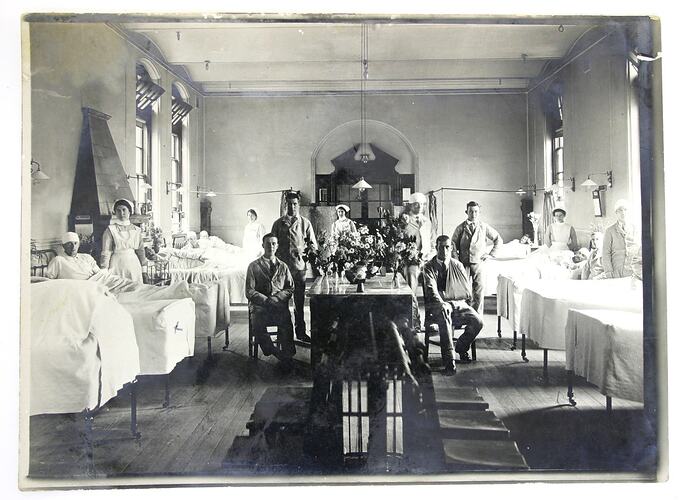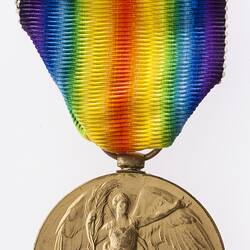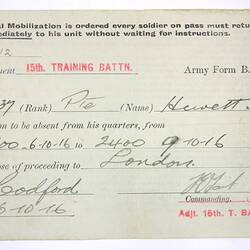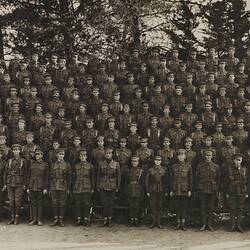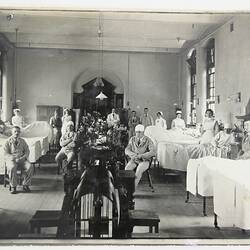Summary
Black and white photograph showing Thomas Joseph Hewitt in the National Hospital, London, circa 1917.
Thomas Joseph Hewitt, service #1937, was a 23-year-old linotype operator when he enlisted in March 1916 in Melbourne to fight in World War I. He was placed in 57th Infantry Battalion - 2 to 5 Reinforcements (April-September 1916), and embarked on 8 July 1916 on the HMAT Ajana. By December he was in France, and on 23 December was taken on strength in the 58th Battalion. On 12 May 1917, the 58th Battalion was in the Hindenberg Line during the Battle of Bullecourt (3-17 May 1917). The Unit Diary reported 'Enemy heavies shelling area in rear of our lines...numerous casualties occurred...fierce hand to hand fighting with rifle and bombs...[after 4.30pm] sector was again vigorously shelled for two hours...During the twenty-four hours the trenches were greatly destroyed. Almost all the posts were blown out...' Special stretcher parties were requested to clear the wounded, which they completed by midnight. Hewitt received a shell wound to head that caused a compound fracture of his skull, and paralysis to his right leg. He was sent to England and admitted to the National Hospital on 23 May, and remained there until 12 September, when he was transferred to hospital in Dartford. His doctor was Dr Farenridge, an Australian. Hewitt was sent back to Australia on 31 October 1917, and spent time recovering in the Caulfield Military Hospital. He was discharged on 2 February 1918 on the grounds of being medically unfit. He lived to the age of 91 years.
Museum Victoria holds two photographs of Hewitt in hospital as well as several personal effects.
Description of Content
View of a hospital room with a floral arrangement and chairs in the centre. Hospital beds line the walls, in which male patients are resting. Two injured men are seated in chairs, with two men standing behind, in the middle ground. Nurses in uniform are standing around the beds.
Physical Description
Black and white photograph. Handwritten inscription in black ink pen on the reverse, with black paper residue from being adhered.
More Information
-
Collection Names
Military Memorabilia Collection, Returned and Services League (RSL) Collection
-
Collecting Areas
Arms, Images & Image Making, Public Life & Institutions, Medicine & Health
-
Acquisition Information
Donation & Subsequent Transfer from Victorian Branch, Returned & Services League of Australia Limited (RSL), Miss A. Casey, 24 Feb 1986
-
Place & Date Depicted
-
Person Depicted
Private Thomas Joseph Hewitt - Australian Imperial Force (AIF), London, England, Great Britain, 23 May 1917 - 12 Sep 1917
-
Format
Photograph, Black & White
-
Inscriptions
Handwritten: He told us the Dept tried to / prove he had not worn his / tin hat but on one Anzac / Day march he met the soldier (named Baker I think) / who carried him to the medical / base & he said he had his / helmet on his head. He also / said he thought he would never / see him again - otherwise he thought / he would die.
-
Classification
-
Category
-
Discipline
-
Type of item
-
Image Dimensions - Photograph
12.2 cm (Length), 16.5 cm (Width)
-
References
58th Battalion Unit Diary, Australian War Memorial HEWITT Thomas Joseph, barcode 5481826, series B2455, National Archives of Australia
-
Keywords
Commemorations, Militaria: Australian, Military Memorabilia, Wars & Conflicts, World War I, 1914-1918, Hospitals
